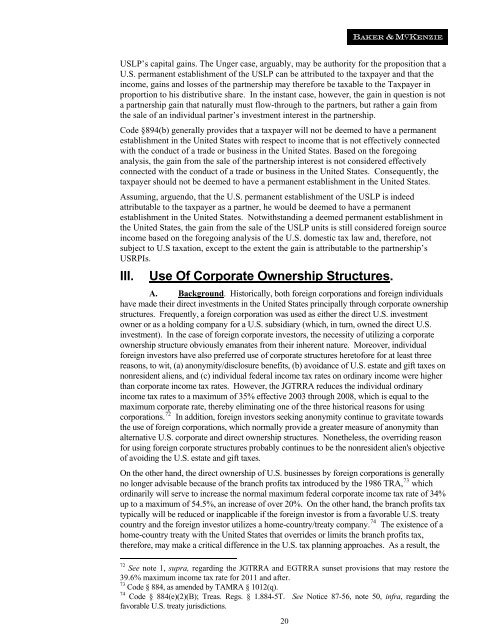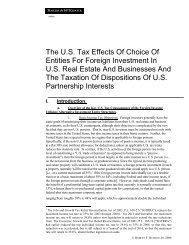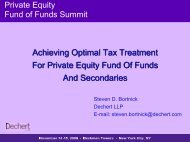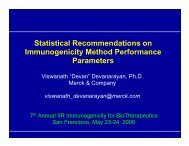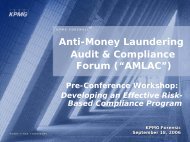The US Tax Effects Of Choice Of Entities For Foreign Investment - IIR
The US Tax Effects Of Choice Of Entities For Foreign Investment - IIR
The US Tax Effects Of Choice Of Entities For Foreign Investment - IIR
You also want an ePaper? Increase the reach of your titles
YUMPU automatically turns print PDFs into web optimized ePapers that Google loves.
<strong>US</strong>LP’s capital gains. <strong>The</strong> Unger case, arguably, may be authority for the proposition that a<br />
U.S. permanent establishment of the <strong>US</strong>LP can be attributed to the taxpayer and that the<br />
income, gains and losses of the partnership may therefore be taxable to the <strong>Tax</strong>payer in<br />
proportion to his distributive share. In the instant case, however, the gain in question is not<br />
a partnership gain that naturally must flow-through to the partners, but rather a gain from<br />
the sale of an individual partner’s investment interest in the partnership.<br />
Code §894(b) generally provides that a taxpayer will not be deemed to have a permanent<br />
establishment in the United States with respect to income that is not effectively connected<br />
with the conduct of a trade or business in the United States. Based on the foregoing<br />
analysis, the gain from the sale of the partnership interest is not considered effectively<br />
connected with the conduct of a trade or business in the United States. Consequently, the<br />
taxpayer should not be deemed to have a permanent establishment in the United States.<br />
Assuming, arguendo, that the U.S. permanent establishment of the <strong>US</strong>LP is indeed<br />
attributable to the taxpayer as a partner, he would be deemed to have a permanent<br />
establishment in the United States. Notwithstanding a deemed permanent establishment in<br />
the United States, the gain from the sale of the <strong>US</strong>LP units is still considered foreign source<br />
income based on the foregoing analysis of the U.S. domestic tax law and, therefore, not<br />
subject to U.S taxation, except to the extent the gain is attributable to the partnership’s<br />
<strong>US</strong>RPIs.<br />
III.<br />
Use <strong>Of</strong> Corporate Ownership Structures.<br />
A. Background. Historically, both foreign corporations and foreign individuals<br />
have made their direct investments in the United States principally through corporate ownership<br />
structures. Frequently, a foreign corporation was used as either the direct U.S. investment<br />
owner or as a holding company for a U.S. subsidiary (which, in turn, owned the direct U.S.<br />
investment). In the case of foreign corporate investors, the necessity of utilizing a corporate<br />
ownership structure obviously emanates from their inherent nature. Moreover, individual<br />
foreign investors have also preferred use of corporate structures heretofore for at least three<br />
reasons, to wit, (a) anonymity/disclosure benefits, (b) avoidance of U.S. estate and gift taxes on<br />
nonresident aliens, and (c) individual federal income tax rates on ordinary income were higher<br />
than corporate income tax rates. However, the JGTRRA reduces the individual ordinary<br />
income tax rates to a maximum of 35% effective 2003 through 2008, which is equal to the<br />
maximum corporate rate, thereby eliminating one of the three historical reasons for using<br />
corporations. 72 In addition, foreign investors seeking anonymity continue to gravitate towards<br />
the use of foreign corporations, which normally provide a greater measure of anonymity than<br />
alternative U.S. corporate and direct ownership structures. Nonetheless, the overriding reason<br />
for using foreign corporate structures probably continues to be the nonresident alien's objective<br />
of avoiding the U.S. estate and gift taxes.<br />
On the other hand, the direct ownership of U.S. businesses by foreign corporations is generally<br />
no longer advisable because of the branch profits tax introduced by the 1986 TRA, 73 which<br />
ordinarily will serve to increase the normal maximum federal corporate income tax rate of 34%<br />
up to a maximum of 54.5%, an increase of over 20%. On the other hand, the branch profits tax<br />
typically will be reduced or inapplicable if the foreign investor is from a favorable U.S. treaty<br />
country and the foreign investor utilizes a home-country/treaty company. 74 <strong>The</strong> existence of a<br />
home-country treaty with the United States that overrides or limits the branch profits tax,<br />
therefore, may make a critical difference in the U.S. tax planning approaches. As a result, the<br />
72 See note 1, supra, regarding the JGTRRA and EGTRRA sunset provisions that may restore the<br />
39.6% maximum income tax rate for 2011 and after.<br />
73 Code § 884, as amended by TAMRA § 1012(q).<br />
74 Code § 884(e)(2)(B); Treas. Regs. § 1.884-5T. See Notice 87-56, note 50, infra, regarding the<br />
favorable U.S. treaty jurisdictions.<br />
20


